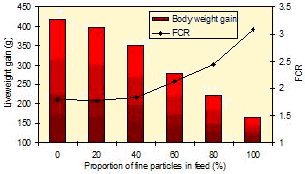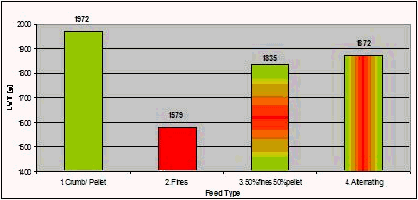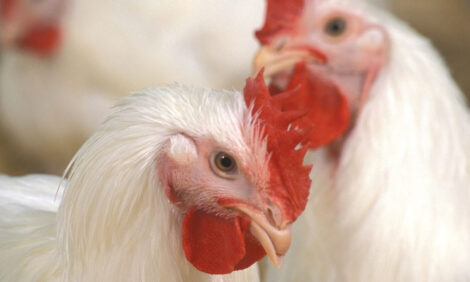



Optimising Nutrient Intake
By Marcus Kenny, Tecnical Development Manager - Nutrition, Aviagen - Poultry feeds are formulated to a specific nutrient concentration to support bird performance. However, growth will be dependant on the bird's nutrient intake.
Feed intake data from Aviagen's own pedigree facility shows that those birds which eat the most feed between 14 and 21 days will have the highest liveweight at 40 days. (Fig 1.)
 Fig 1. The relationship between early feed intake (14 - 21d) and 40 day bodyweight
|
To achieve optimal growth, it follows that feed and bird management must be focused on maintaining good levels of feed intake.
Factors affecting intake
Many factors will influence feed consumption, environment and management being two of the most important. Feed form is known to have a significant impact on consumption; the negative effect of high levels of fines has been well documented. More recent research has shown significant effects of increased levels of fines on reducing liveweight and FCR (Fig 2.)
 Fig. 2. The influence of fine particles in the feed on broiler performance (Quentin et al., 2004)
|
The majority of commercial broiler diets have been through the pelleting process. However the durability of pellets can be variable with levels of fines as high as 50%. Incidences of high levels of fines in the field are associated with poor liveweight and FCR.
To maximise performance the accumulation of fine particles in the feed should be minimised, allowing the birds to eat out all the feed in the system at least once per day.
Aviagen recently explored the effect of feed form on broiler performance in a field trial. In the trial birds were fed a high quality wheat based control diet or a treatment in which this was roller milled to fines - the diets were fed for a period of 10 days. This created two extremes as shown in Fig 3. At 10 days of age the liveweight of birds fed the treatment diet was, on average, 50g lower than that of birds fed the control diet (234g vs. 284g), and FCR was increased by 21 points (1.26 vs. 1.05). Thus feed form has a significant effect on early broiler performance leading to a reduced liveweight, poorer FCR and a worse uniformity.
 Fig. 3. Diet types used in Aviagen Field Trial looking at the influence of feed form on early broiler performance
|
A further study examined the effect of the same feed forms fed to 35 days, the same starter preparations were fed as in the field experiment to 10 days followed by a grower diet as either pellet or fines. This trial showed there was a significant impact on both early and older weights, the fines treatment reducing liveweight by 15% at 32 days (Fig 4.)
| Fig 4. The effect of feed form on broiler bodyweight | ||||
| Age | Bodyweight (g) | Difference | ||
| days | Control | Mash | (g) | (%) |
| 10 | 265 | 242 | 23 | 9 |
| 20 | 859 | 721 | 138 | 16 |
| 32 | 2077 | 1765 | 312 | 15 |
| 39 | 2829 | 2502 | 327 | 12 |
| 46 | 3420 | 3107 | 313 | 9 |
We also looked at the impact of different levels of fines fed to 31 days. The control (1) was, as in the previous experiments, a good quality starter crumb and grower pellet, treatment 2 was 100% fines, treatment 3 was an intermediate level of fines created by mixing equal weights of the control and treatment 2 feeds, treatment 4 was created by alternating the fines/pellet treatment throughout the growing period. (Fig 5) .
The results showed treatment 2, the (100% fines) reduced liveweight by 20%; slightly worse than the previous trial. Treatment 3, the intermediate fines and alternating regime reduced liveweight by 7%. (Fig 5) and treatment 4 the alternating regime reduced liveweight by 5%.
In conclusion the trials confirm that the higher the level of feed fines the lower the performance will be, regardless of the manner the fines are presented.
 Fig 5. The effect of feed physical form on broiler liveweight
|
The economic benefit of improving feed form
The last trial data can be used to calculate the economic effect of poor feed form.
Control - 100% pellets = 1.972kg at 31 days.
Treatment 2 - 100% fines = 1.579kg at 31 days
Difference = 0.393kg
The effect of reducing fines to 0% gave an increase in bodyweight by 393g/bird at 31 days. This difference was purely due to feed form; the formulations & pre-treatment were identical. In terms of value, if liveweight prices are calculated at 0.50 ? per kg, this additional weight is worth 19.5 ? cents per bird.
This calculation is based on response data from Aviagen trials and may not always reflect field conditions. However it does show that there is significant scope for improvement in both biological and financial performance if feed form is improved.
Means of Improving Pellet Durability
Pellet durability may be improved by manipulation of diet formulation; use of raw materials with good binding ability such as wheat, barley, rape and use of pellet binders will have an influence.
Feed manufacturing practises will also have an effect on pellet durability and potentially involve less expense than raw material addition.
Grinding of raw materials and conditioning of feed are regarded as the most influential factors affecting pellet quality.
Grinding
There are several reasons to grind raw materials, it improves uniformity of mixing, increases absorption of steam and increases digestibility of feed. In terms of pellet quality grinding reduces the amount of large particles which can reduce pellet strength; it also increases surface area for feed particles to adhere. In other words a finer even grind can result in better pellet quality.
Points to consider when grinding are;
- Screen hole size - appropriate for the grist (particle) size and pellet size required.
- Screen correct side to hammers - provides more efficient grinding.
- Hammer tip speed - faster will produce finer material.
Conditioning
Conditioning has probably the most influence on pellet quality.
Conditioning creates thermal, chemical and mechanical energy; the steam used during conditioning opens up starches and causes gelatinisation and also plasticizes proteins and softens fibres. Optimal 'cooking' of feed will result in more durable pellets.
To ensure optimal conditioning the following points should be considered;
-
Steam pressure into the conditioner needs to be kept low (<2 Bar) and constant as high pressure 'blasts through' the meal. Low pressure steam transfers heat to the meal more efficiently than high pressure steam.
-
Steam temperature needs to be about 135 degrees centigrade to adequately condition the feed, ideally the temperature in the conditioner should be greater than 80 degrees centigrade.
-
The dwell time of the meal in the conditioner will influence pellet durability, depending on the temperatures involved, meal retained longer will generally result in better conditioning.
-
The level of meal in the conditioner will affect conditioning efficiency, too low and dwell time is reduced, too high and the mechanical effect of the conditioner is reduced.
-
The point of addition of steam into the conditioner should be below the meal fill level if it's above this steam may not penetrate the meal efficiently.
Pelleting
Along with grinding and conditioning, pelleting also has an influence on pellet quality See Fig 6. Meal should enter the pelleter correctly conditioned as this will aid 'shaping' the meal into pellets rather than cooking the meal via friction heat at the die. Excess friction heat in the die can produce a hard brittle pellet rather than a durable one, also conditioning the meal in the conditioning vessel is more cost efficient than in the pelleter.
Consideration should be given to:
-
Cheaper dies are usually a false economy as they are likely to be lower quality resulting in uneven wear and therefore poor pellet quality and throughput.
-
The number of die holes will affect the throughput and rate of wear of die.
-
Die hole dimension will affect pellet quality, consider the effect of die length on compression and throughput, the longest die hole may not always give the best quality.
-
Faster die speed will increase throughput but reduce pellet quality.
-
Meal must be fed evenly across the full face of the die otherwise there may be uneven die and roller wear which results in poorly formed pellets reducing pellet quality.
Quality Control
Pellets should be tested for durability on an ongoing basis, the aim being to test the ability of the product to remain as a whole pellet from the mill to when it is presented to the bird.
There are generally two mechanisms available which mimic field conditions.
-
The tumbling can - involves placing a weighed sample of material into a rotating chamber for a set period of time, usually 10 minutes at 50 r.p.m.
-
The Holmen tester - the weighed sample of pellets are pneumatically conveyed around a closed pipe, usually 30 seconds.
The guideline durability for both measurements for 2 to 3mm pellets is as follows;
| Test | Durability Index | Time |
| Tumbling Can | 98% | 10 minutes |
| Holmen Test | 95% | 30 seconds |
In summary
-
It is vital birds receive optimal feed intake to achieve optimal growth.
-
Feed form has a significant impact on broiler performance.
-
Improving feed form involves significant profit opportunities.
-
Feed form may be improved at little cost by manipulating feed formulations or feed manufacturing practices.
-
Grinding, conditioning and pelleting practices make a significant contribution to pellet quality.
-
There are many means to improve pellet quality cost effectively.
-
Assessing pellet quality at the mill is essential to ensure improvements made to pellet quality are maintained.









